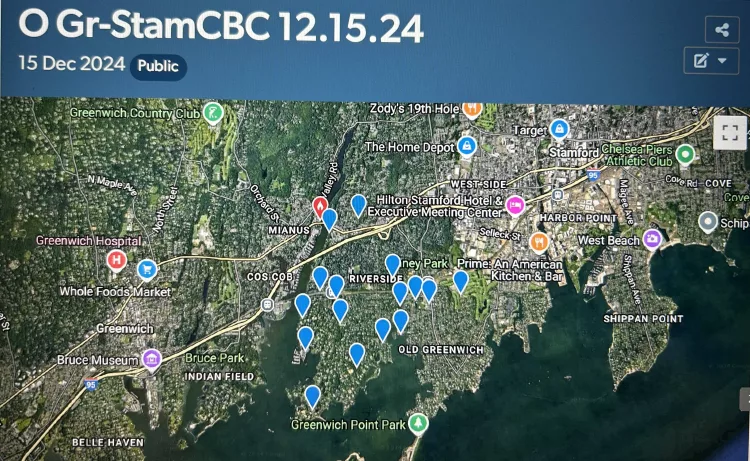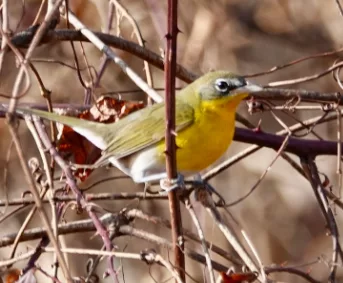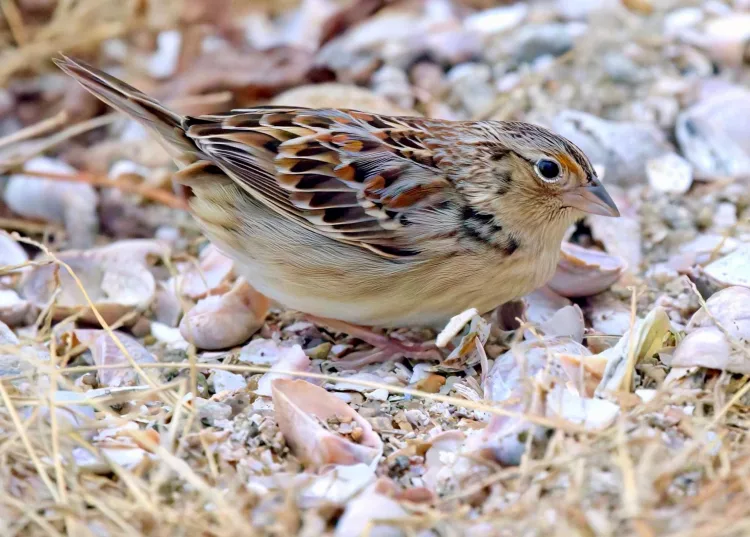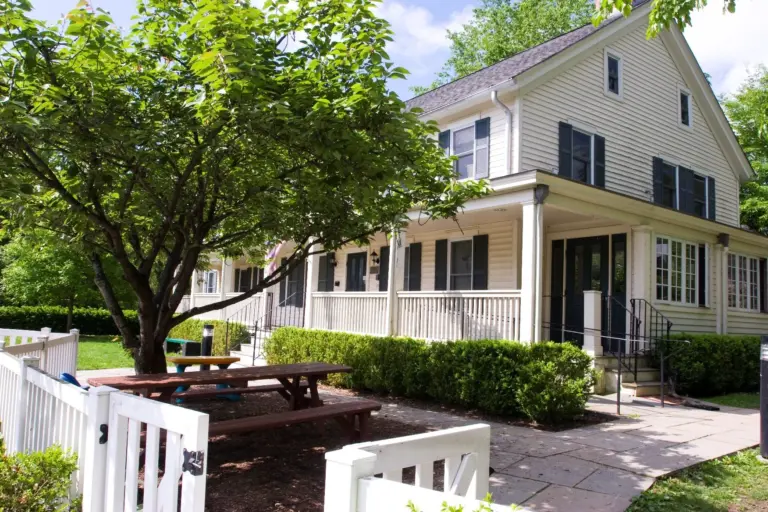
By Anne W. Semmes
It’s the 125th annual Audubon Christmas Bird Count (CBC), the nation’s longest-running community science bird project, occurring December 14 through January 5, when many thousands of volunteers across the U.S. brave snow, wind, or rain to count bird species to assess the health of bird populations, to help guide conservation action.
Cynthia Ehlinger, the noted Greenwich birder, has been counting those species for the CBC from the age of 10 joining her mom, she tells. Ehlinger now counts 30-plus years of spotting birds in CBC’s Greenwich-Stamford circle. “Our circle started around 1911,” she tells, “Not quite as old as the very first one. It was chosen for the variety of birds that we could get, and to make sure we get out into the Sound where we get some of the water birds that you wouldn’t see otherwise. Fortunately, we have somebody who does go out on a boat so that we can get some of those water birds.”
That Greenwich-Stamford circle with its 15-mile diameter stretches from Armonk near the Westchester Airport, and over to Darien and New Canaan, tells Ehlinger. “So, it’s a fairly wide area. So, we break it up into 19 territories.”
Ehlinger’s title is Compiler for all those 19 territories – each identified by a letter. She inherited that title from long-serving Greenwich Audubon birder Gary Palmer who now has his own territory in that circle. Ehlinger’s territory – called Area O, she describes as including Riverside below Palmers Hill Road over to the Old Greenwich School. And in her particular territory Ehlinger had three other observers, “and we broke into two groups,”.
“So, when we do the data, it asks for party hours and party miles, and how many observers there are and how many parties. So, in my territory, I had one party, which was myself, and in the afternoon one other person. And I had another party of two who did a different section of my territory. And that way we can cover a lot more, get to see birds that if I were to do it all myself or were we together, we probably wouldn’t get all the birds that we could see.”
So, for Ehlinger on December 14, “The weather was fairly pleasant…It wasn’t terribly cold, it wasn’t rainy or snowy. Nice for the people, but it doesn’t always help for the birds…You get a lot more birds coming to feeders when its freezing.”
The total species count for Compiler Ehlinger on that day for the Greenwich-Stamford circle was 106. “The average is around 111 so it was lower than normal.” And the most unusual birds in that 106? “A Grasshopper Sparrow…seen at Greenwich Point,” tells Ehlinger. “I believe that was the first time we’ve ever seen one on our count.”
She explains how the count begins with a count week. “It’s three days before the actual count day, then three days after the count day. They’re like placeholders to let you know that there are those birds in the area, but they don’t count in Audubon’s official data unless seen on that particular day of December 14.”
“We had a King Eider,” she shares, “that flew by the day after our count…So that would be a count week bird, which I would put in our personal database, and also in the National Audubon database.” Count also a Greater white-fronted Goose, but not on December 14. “It has come back the last four or five years to a little pond in Rye, behind a shopping center…We were hoping it would come back. We were very excited that we would get it for the count. And then for the count day, it seemed to disappear. And then it showed up again.”

That Greater white-fronted Goose Ehlinger tells is not an Eastern bird. “It breeds from Alaska…then migrates through the plains down into the Gulf area of Louisiana and over into Mexico.” Then there were birds regularly seen but now often missing like the Bonaparte’s gull, “which you would see out in the Sound,” says Ehlinger. But for the last five years or so “it’s been hit or miss. We got it for count week, but not for the count day.”
So, are sound recordings used to pull in birds? Often used for owls, she says, but not otherwise. “We try to go by best practices, Generally, you’re looking and you’re listening. If you are in a place where you think something is, you might do some phishing, which is just an annoyance sound that the birds come out to see what’s going on.’ And “You’re driving from spot to spot, and then in some cases you do a lot of walking, and other places you just stop for a few minutes depending on what it is.”
And when is the starting time? “Most people start at about dawn, and that’s usually around seven o’clock that late in December. Some people start about three in the morning to try for owls. So not everybody goes out for the owls, but we do alert the police department, so that they know if there are people in cars with binoculars and they’re making weird sounds, they know what’s going on.”
And when does the counting stop? “When it starts getting darker around four o’clock. Sometimes you get through with your territory around three, but it’s generally an all-day thing, maybe with a break a couple of times for a snack or something.”
And what follows is the birders community gathering time. “The Audubon Center hosts a compilation potluck dinner. So, the price of admission is to bring something to eat that you can share. We started at 5:30 p.m. although people could come earlier if they wanted. Some 30 people came. We had a little more than half (60-plus) of the total observers.”
“Once everybody’s had something to eat,” she continues, “I have a checklist that I’ve previously given people. We’ll go through the checklist, and I’ll read each species first to see what’s been seen and what hasn’t been seen. They can either use their checklist, or they can use eBird trip reports to share with me so we can get the data.”
“Once we go through the list people will shout out yes if they had it in their territory. And the list doesn’t have every single rare bird, so at the end we’ll go through each territory, and people will comment on something rare they saw in their territory.”
And what is Ehlinger’s takeaway. “I enjoy the sense of community with a lot of people getting together for a similar purpose. To enjoy being outside, but also to contribute to learning more about the population of our birds, which can go to educating the greater population about what the status of the birds are. But it’s the community of birders, it just brings us together at a time when you don’t necessarily think about going outside.”
For more information on the Christmas Bird Count visit Audubon.org/community-science/Christmas-bird-count





